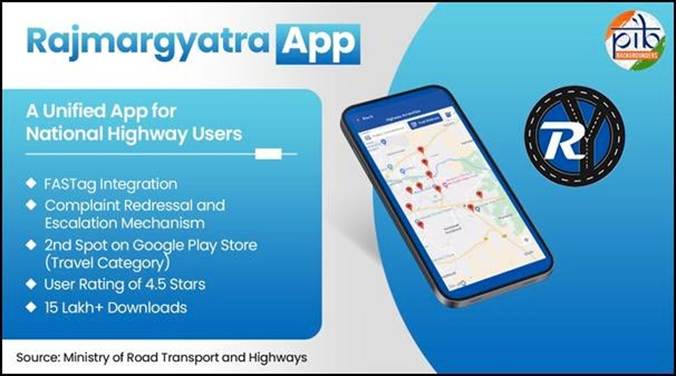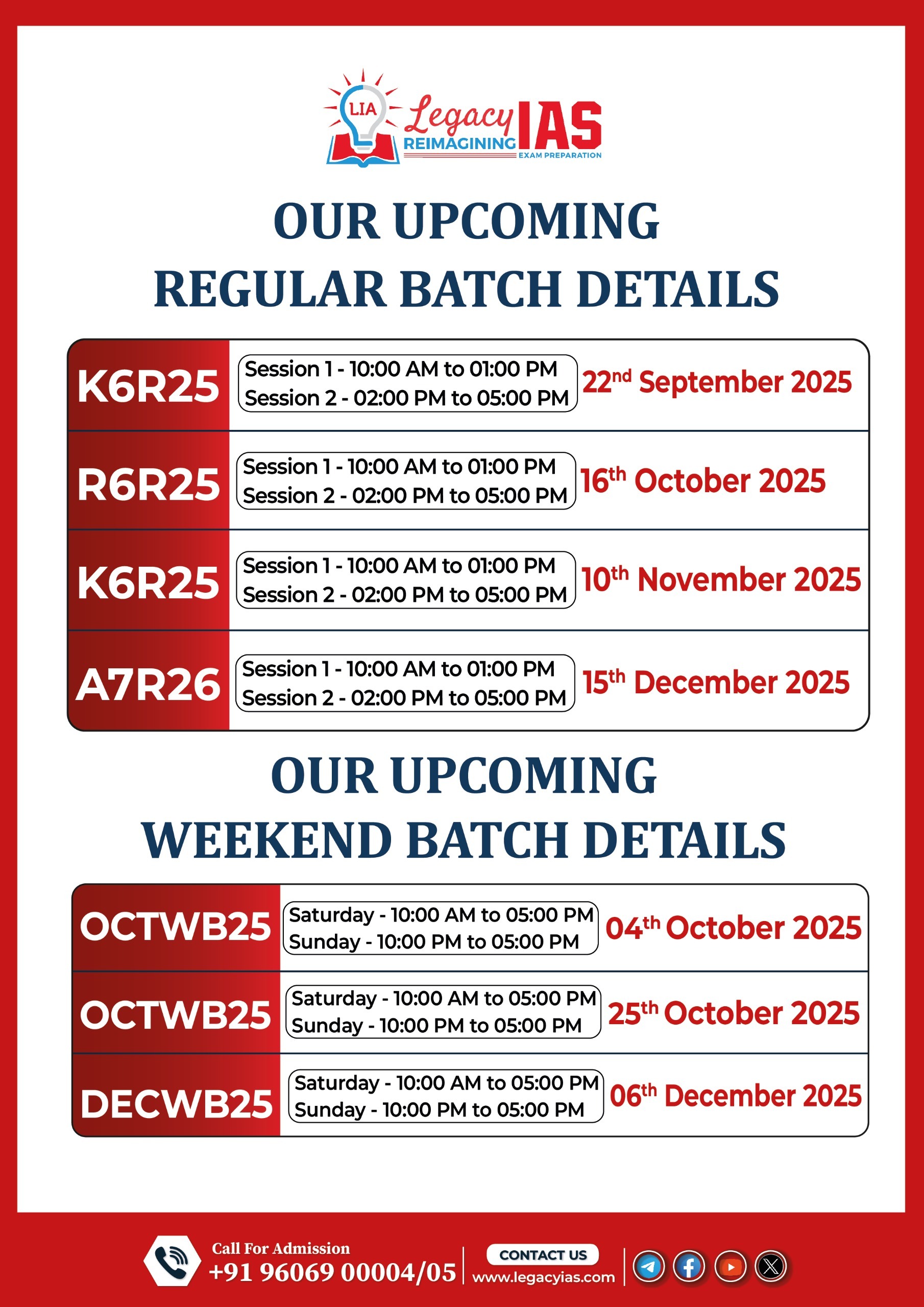Content
- Redefining India’s Highways
- From Urban Hubs to Rural Heartlands
Redefining India’s Highways
Why in News ?
- India is undergoing a digital transformation of its National Highway infrastructure, integrating smart technologies, real-time data systems, and sustainable practices.
- Key new initiatives:
- Rajmargyatra App for citizen-centric highway management.
- NHAI One app for internal digital governance.
- Launch of Multi-Lane Free Flow (MLFF) tolling.
- Integration of GIS & PM Gati Shakti for planning.
- Strengthened Green Highways Mission and sustainability initiatives.
Relevance
- GS 3 (Infrastructure & Economy): Expansion and modernization of road infrastructure; logistics efficiency; economic impact of highway development.
- GS 3 (Science & Technology): Use of AI, GIS, IoT, and RFID in transport governance (digital tolling, MLFF, ATMS, V2X).
- GS 2 (Governance): E-governance initiatives (Rajmargyatra App, NHAI One), citizen-centric delivery, transparency, and accountability mechanisms.
Context and Scale
- India’s total road network (March 2025): 63 lakh km (2nd largest globally).
- National Highways (NHs): 1.46 lakh km (up ~60% since 2013–14, from 91,287 km).
- 54,917 km of NHs added between 2014–2025 — reflecting physical expansion and digital modernization.
- Digital transformation adopted across all phases of highway lifecycle:
- Planning → DPR → Construction → Maintenance → Tolling → Monitoring.

Digital Tolling Revolution
a) FASTag & NETC System
- Implemented by National Payments Corporation of India (NPCI) under National Electronic Toll Collection (NETC) framework.
- RFID-based FASTag: Enables automatic toll deduction.
- Penetration: ~98%; Users: 8+ crore.
- FASTag Annual Pass:
- ₹3,000 for non-commercial vehicles (1-year validity / 200 toll crossings).
- Activated via Rajmargyatra/NHAI website.
- 25 lakh+ users, 5.67 crore transactions in two months post-launch (Aug–Oct 2025).
b) Revised Tolling Rules (Nov 2025)
- Non-FASTag vehicles: Double fee.
- UPI users: 1.25× fee.
- Objective: promote digital tolling, reduce congestion, increase transparency.
c) Multi-Lane Free Flow (MLFF) Tolling
- Launched (Aug 2025) at Choryasi Fee Plaza, NH-48, Gujarat.
- Barrier-free, camera- and RFID-based tolling system.
- Enables toll deduction without stopping; reduces fuel, time, and emissions.
Rajmargyatra App — Citizen-Centric Highway Interface
- Developed by Ministry of Road Transport & Highways (MoRTH).
- Functions:
- Real-time info on highways, toll plazas, nearby facilities (fuel, hospitals, EV chargers, weather).
- Integrated with FASTag for toll payments.
- Complaint system: Geo-tagged photo/video uploads for issues like potholes, safety hazards.
- Features: multilingual support, speed alerts, voice assistance.
- Performance:
- 15+ lakh downloads; 4.5★ rating.
- Ranked #23 overall and #2 in travel category (Play Store).
- Top government app post FASTag Annual Pass integration.

NHAI One — Internal Digital Backbone
- Integrates 5 core operations:
- Field Staff Attendance
- Highway Maintenance
- Road Safety Audits
- Toilet Maintenance
- Daily Construction Audits (RFIs)
- Stakeholders: Regional Officers, Project Directors, engineers, auditors, contractors.
- Features: geo-tagging, time-stamping, and real-time reporting.
- Objective: enhance accountability, streamline workflows, bridge gap between execution and public service delivery.
GIS & PM Gati Shakti Integration
- PM Gati Shakti National Master Plan (NMP): digital platform for integrated infrastructure planning.
- GIS-based NMP Portal: 550+ data layers — economic, environmental, logistical.
- All 1.46 lakh km NHs mapped and validated on the portal.
- Impact: faster clearances, efficient alignment, reduced project delays, and ecosystem-friendly planning.
Intelligent Transport Systems (ITS)
a) Advanced Traffic Management System (ATMS)
- Enables real-time monitoring, incident detection, automated enforcement.
- Deployed on major expressways:
- Delhi–Meerut, Trans-Haryana, Eastern Peripheral, Bengaluru–Mysore.
- Impact: Significant drop in accidents post-ATMS adoption (e.g., Bengaluru–Mysore, July 2024).
b) Vehicle-to-Everything (V2X) Ecosystem
- Future integration of vehicle, infrastructure, and communication networks for predictive traffic management.
c) Smart Transparency Initiatives
- Project Information Sign Boards with QR codes for project details and amenities.
- Network Survey Vehicles (NSVs) with 3D laser systems, 360° cameras, deployed across 23 states, covering 20,933 km, to detect defects automatically.
Green & Sustainable Highways
a) Green Highways Mission (2015 Policy)
- Goals: reduce pollution, control erosion, generate jobs, beautify corridors.
- Tree plantation:
- 56 lakh (2023–24) + 67.47 lakh (2024–25) = 4.69 crore trees total since inception.
b) Water Body Restoration (Mission Amrit Sarovar, 2022)
- 467 water bodies developed.
- Generated 2.4 crore m³ soil for road use → ₹16,690 crore cost saving.
c) Use of Recycled Materials
- 631 lakh metric tonnes of fly ash, plastic waste, and reclaimed asphalt used (2023–24).
- Promotes circular economy and eco-friendly construction.
Strategic and Developmental Significance
- Economic: reduces logistics cost (~13–14% of GDP) by improving efficiency.
- Governance: enhances transparency, accountability, and real-time monitoring.
- Environmental: integrates green, sustainable practices and emission reduction.
- Technological: integrates GIS, IoT, AI, RFID — core of India’s Digital Infrastructure Mission.
- Citizen-centric: Rajmargyatra app empowers commuters; grievance redressal + safety tools.
- Global Positioning: aligns with India’s G20 infrastructure agenda and SDG 9 (Industry, Innovation & Infrastructure).
Challenges Ahead
- Digital divide and interoperability of tech systems.
- Data privacy and cybersecurity in highway digitization.
- Maintenance of digital and physical infrastructure simultaneously.
- Funding for MLFF nationwide rollout and ITS expansion.
Conclusion
India’s highways are transitioning from physical assets to smart, data-driven ecosystems — blending infrastructure, intelligence, and inclusivity.
The integration of digital tolling, GIS planning, ATMS, and sustainability missions redefines mobility governance and sets the foundation for a connected, climate-conscious, and citizen-responsive transport future.
From Urban Hubs to Rural Heartlands
Why in News ?
- The Government of India announced expansion and digital transformation of KVS & NVS institutions to further educational equity and NEP 2020 goals.
- Key recent approvals:
- 57 new Kendriya Vidyalayas (2025–2034) with ₹5,862.55 crore outlay.
- 28 new Navodaya Vidyalayas (2024–2029) with ₹2,359.82 crore outlay.
- Upgradation under PM SHRI: 913 KVs and 620 NVs as model schools implementing NEP 2020.
Relevance :
- GS 2 (Education & Governance): Role of KVS and NVS in delivering equitable quality education; implementation of NEP 2020 and PM SHRI scheme.
- GS 2 (Social Justice): Bridging rural–urban, gender, and socio-economic divides through inclusive schooling (Balvatika, ECCE, reservations).
- GS 2 (Government Policies): Evaluation of government flagship programmes — PM SHRI, Balvatika, and ECCE integration within NEP framework.
Understanding KVS & NVS
| Parameter | Kendriya Vidyalaya Sangathan (KVS) | Navodaya Vidyalaya Samiti (NVS) |
| Established | 1963 (from Central Schools Organisation, 1962) | 1986 (under National Policy on Education, 1986) |
| Ministry | Ministry of Education (MoE), Govt. of India | Ministry of Education (MoE), Govt. of India |
| Nature | Co-educational, non-residential, CBSE-affiliated schools | Fully residential, co-educational, CBSE-affiliated schools |
| Target Group | Wards of Central/State Govt. employees, Defence & PSU personnel | Talented rural students (75% seats for rural areas) |
| Funding | 100% Central Government | 100% Central Government |
| Medium | English/Hindi | Regional language up to Class VIII, then English/Hindi |
| Focus | Uniform quality education & national integration | Equity, inclusivity, and rural talent development |
Scale and Reach (as of Oct 2025)
- KVS: 1,290 functional schools → 13.7 lakh students.
- NVS: 662 operational schools → 3.1 lakh students.
- Total Reach: Over 16.5 lakh students nationwide, bridging urban-rural disparities.
Evolution & Policy Framework
- KVS: Started 1963 for mobility of govt. employees’ children; now pan-India with digital & NEP 2020-aligned pedagogy.
- NVS: Born from NPE 1986 to nurture rural merit; one school per district model.
- Both follow CBSE + NEP 2020 + National Curriculum Framework (NCF) 2023 guidelines.
2025 Expansion & Budgetary Highlights
- KVS Expansion:
- 57 new KVs approved with ₹5,862.55 crore for 9 years (2026–2034).
- ₹2,585.52 crore (Capital) + ₹3,277.03 crore (Operational).
- NVS Expansion:
- 28 new NVS approved (2024–29) with ₹2,359.82 crore.
- ₹1,944.19 crore (Capital) + ₹415.63 crore (Operational).
- Budget Support (2024–25):
- NVS: ₹5,370.79 crore Grant-in-Aid; total available funds ₹6,000.83 crore.
- KVS: Continuous expansion backed by MoE and PM SHRI allocations.
Digital Transformation
a. KVS
- 90% schools now have smart classrooms, AI learning tools, and virtual labs.
- Integrated with DIKSHA for adaptive NEP-aligned content.
- Focus: hybrid learning, vocational modules, multilingual digital pedagogy.
b. NVS
- 9,417 Smart Classrooms + 312 Digital Language Labs.
- 311 schools with leased-line internet; rest with broadband.
- 26,118 desktops across NVs.
- Supported by PM SHRI and CBSE CSR digital projects.
PM SHRI Scheme: Transformative Catalyst
- Launched: 2022; Outlay: ₹27,360 crore (2022–27).
- Goal: Upgrade 14,500+ schools as NEP-exemplar institutions.
| Parameter | KVS Impact | NVS Impact |
| Upgraded Schools | 913 | 620 |
| Focus Areas | Smart classrooms, AI integration, eco-clubs, leadership hubs | Innovation labs, cultural integration, rural talent incubation |
| Alignment | NEP 2020 – experiential learning, skill orientation | NEP 2020 – equity, inclusion, digital literacy |
| Beneficiaries | ~10 lakh students | ~3 lakh students |
ECCE & Balvatika Integration
- ECCE (Early Childhood Care & Education) under NEP 2020 ensures foundational literacy & numeracy by Grade 3.
- Balvatika Program in KVS:
- Operational in 505 schools (Balvatika I–III for ages 3–8).
- 57 new KVs (2025) to include Balvatika from inception (capacity ~13,680).
- Emphasis on play-based, multilingual, inclusive learning (3% seats for differently-abled).
- NVS Contribution: Bridges ECCE through remedial foundational programs for rural entrants at Class VI level.
Urban–Rural Equity: Comparative Infrastructure
| Aspect | KVS (Urban/Semi-Urban) | NVS (Rural/Remote) |
| Infrastructure Focus | Smart Classrooms, Language Labs, AI tools | Self-contained residential campuses |
| Curriculum Adaptation | STEM, AI, Coding, Vocational Labs | Multilingual, Contextual Rural Curriculum |
| Accessibility Goal | Mobility & uniformity for Govt. employees | Equity & opportunity for rural merit |
NEP 2020 Implementation
- Both institutions serve as NEP 2020 pilots for school reforms:
- 5+3+3+4 structure, competency-based assessment, multilingualism, experiential pedagogy, and teacher training.
- Integration of digital learning, vocational skills, and foundational literacy in curriculum delivery.
Significance & Impact
- Bridging Divides: Urban-rural, linguistic, digital, and socio-economic.
- Equitable Access: Education for 16.5 lakh+ students across all states/UTs.
- Digital Equity: Reduced digital divide through ICT and AI in classrooms.
- National Integration: Inter-state student migration (especially in NVS) builds unity in diversity.
- Future Readiness: Embeds skills, coding, and AI literacy for India’s demographic dividend.
Challenges
- Teacher shortages, especially in remote NVSs.
- Maintenance of infrastructure & tech support in rural regions.
- Bridging gaps between digital readiness of teachers and systems.
- Ensuring continuity in budgetary flows for expansion and quality enhancement.
Way Forward
- Strengthen teacher capacity-building via digital platforms (NISHTHA 2.0).
- Expand Balvatika & ECCE coverage to all new KVs and feeder schools to NVS.
- Deepen AI-driven personalised learning and rural broadband connectivity.
- Continuous impact audits for PM SHRI upgrades to track NEP 2020 outcomes.
Conclusion
- KVS (1963) and NVS (1986) form India’s twin pillars of educational equity and excellence.
- 2025 marks a watershed with digital empowerment, institutional expansion, and NEP alignment.
- Through PM SHRI integration and Balvatika foundations, they exemplify urban efficiency meeting rural empowerment, shaping India’s unified, inclusive education future.



